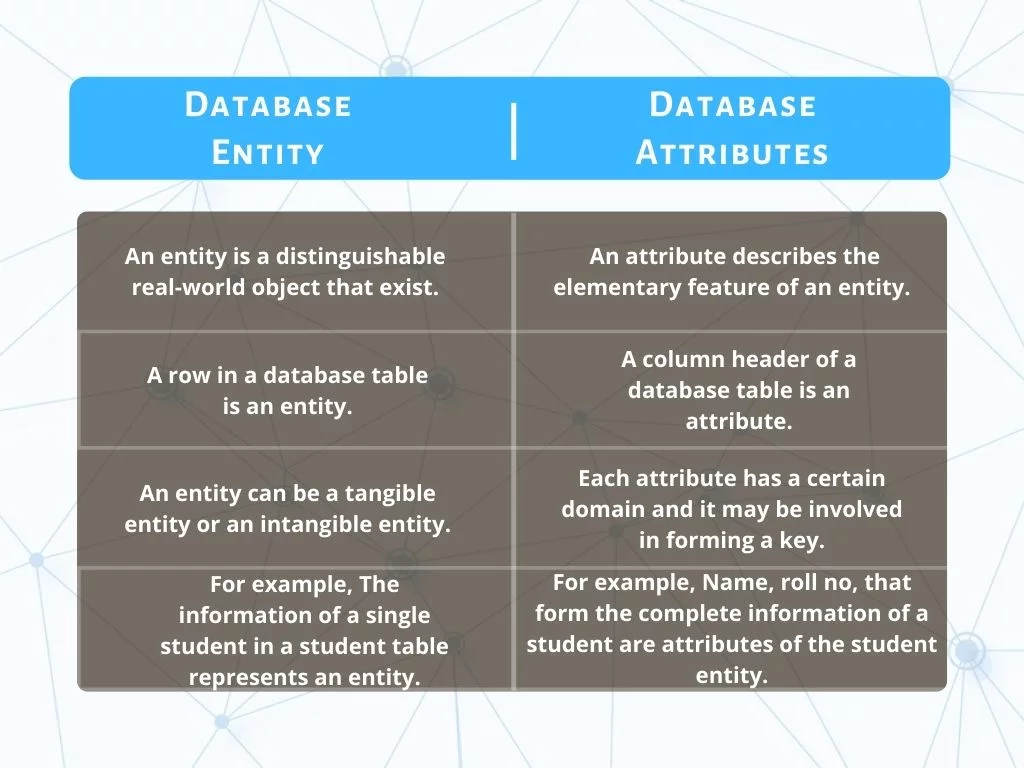To understand the concept of database entities and attributes, we must know about Database Management System first. The database is a collection or set of data related to each other. The database is used to organize the data in a meaningful way.
Entity and Attributes are two essential terms of a database management system (DBMS). The main difference between the Entity and an attribute is that an entity is a real-world object, and attributes describe the properties of an Entity. The Entity may be tangible or intangible. Here in this article, we will discuss some important features of database entities and attributes and how they are different.
We need software or a system to manage the data, and this is where the database management system comes into action. Organizations use software to maintain the database—for example, Oracle database and MySQL.
Database Management System has its own set of interfaces to perform various operations on a database like creating a new database, storing or deleting the data in the database, etc. It is a secure way to maintain the database.
The database is a set of related data. To relate the data ER model is used. ER model creates a conceptual model of the database. With the help of the ER model, we can straightforwardly view the data. Adobe all, the components of the ER diagram consist of Entity, Attributes, and the different types of relationships between the entities.
What Is an Entity in a Database?
The Entity is anything that has a physical existence like an object, person, place, etc. Entity type describes the type of the object. For example, if E1 is an entity and the type of E1 is an employee, then all employees are known as an entity set. In the ER model, the entity type is represented in a rectangular shape. There are two different types of entities:
Tangible Entity
The Entity or Object which exists in the physical world is known as the Tangible Entity. For example, a Person, bike, place, etc., live in the real world, and therefore they are called Tangible entities.
Intangible Entity
The Entity or Object that has a logical definition but does not exist physically is known as an Intangible Entity—for example, a Bank account, etc.
The collection of an object with similar attributes is known as the entity type. For instance, if E1 is Employee One and E2 is Employee Two, both E1 and E2 have the exact attributes. Therefore, E1 and E2 will be considered under the Employee entity type. Also, there are two types of Entity types in the database management systems.
Types of Entity Type:
Strong Entity
Weak Entity
Strong Entity Type
Firstly, the entity type is a set of similar entities. Secondly, they also have common attributes. To identify each Entity, we need an attribute with unique values that can identify the Entity. Similarly, we can say it is a Key attribute.
The entity type with a key attribute is known as a Strong Entity Type. Strong Entity Type is present in a rectangular shape in the ER model. For example, Employee is an Entity type that has a key attribute Employee.
Weak Entity Type
This type of entity doesn’t have the main attribute. Weak entity type requires other entities for its precise identity. For a clear understanding of weak-type entities, we can take a real-life example. Likewise, there is an existence of children if parents exist, and there are rooms if a building exists. Therefore, the term Identifying relationship shows the relationship between weak and strong entity types.
The Database management system comprises the Entity-Relationship model, i.e., the ER Model. By using the ER model, we can demonstrate the related data elements and any specified system. This Entity-Relationship model is a combination of attributes and entities.
The Entity is just an object, place, or Person that attributes can define. In short, attributes provide extra details about the Entity. For the representation of an Entity, we can use Rectangle. For instance, in an organization, we use the term entity for Employees, Departments, etc.
Eclipse is a representation of Attributes. Further, if the Employee is an entity, then Name, contact number, etc., are attributes of that Employee.
The following are the different types of attributes in a database management system:
- Simple Attributes
- Composite Attributes
- Single Valued Attributes
- Multi-Valued Attributes
- Derived Attributes
Database Management System-Simple Attributes:
Atomic Attributes is another name for Simple Attributes. They are independent and can not be classified further. We can take a small example of simple attributes. For a class of students, consider the student as an entity. Hence, the Entity consists of different attributes such as age, roll no, etc. And the division of roll no. or age is not further possible.
Database Management System-Composite Attributes:
Composite attributes have different types when it is possible to split. In Composite attributes, we can separate them into parts that form simple attributes. For example, if the Name is an entity, we can subdivide it into First Name, Middle Name, Last Name, etc. These all sub-attributes are simple attributes.
Single-Valued Attributes:
Single-valued attributes fill the Entity values that provide a detailed description of it. However, the type attribute that stores only one value is a single-valued Entity. Lastly, Date of birth, Gender is an example of Single-Valued attributes.
Multi-Valued Attribute:
Opposite to Single-Valued Attributes, Multi-valued attributes store the multiple values of an entity. For example, take an employee as an entity with different attributes such as Email id, Phone number, etc. Most importantly, by using multi-valued attributes, we can store different values under them.
Derived Attributes:
Derived Attributes are the attributes that come from the values of another attribute. Moreover, if the Date of Birth attribute is available, we can find the age attribute. But, it shows the dependency of one attribute on another. In other words, it means the calculation of one attribute value is dependent on another attribute value.
Conclusion:
In Database Management System, there are different types of attributes that store the values of the Entity. In the Entity-Relationship model, attributes are also essential to describe the entity relationship. Hence, Attributes and Entities are different parameters in DBMS. They are dependent on each other and play an essential role in the database management system.
You May Also Like to Read:
Know more about Data Abstraction Examples that Benefit Businesses
Computer Hardware Security Devices You Should Be Aware About


